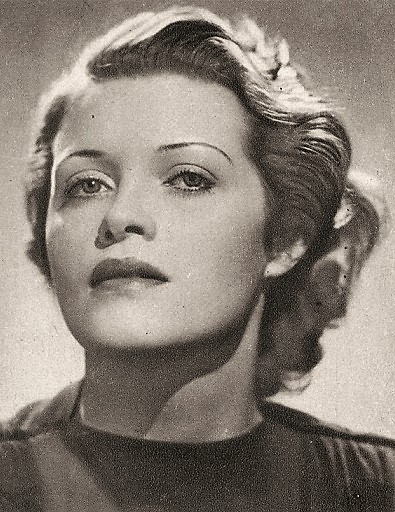

Queer Places:
Ostfriedhof, St.-Martins-Platz 1, 81541 München, Germany
 Sybille
Maria Christina Schmitz (2 December 1909 – 13 April 1955) was a German
actress.
Sybille
Maria Christina Schmitz (2 December 1909 – 13 April 1955) was a German
actress.
Schmitz attended an acting school in Cologne and got her first engagement at Max Reinhardt's Deutsches Theater in Berlin in 1927. Only one year later, she made her film debut with Freie Fahrt (1928), which attracted her first attention from the critics. Her other early movies include Pabst's Diary of a Lost Girl (1929), Dreyer's Vampyr (1932), and eventually F.P.1 (1932), where she played her first leading role.
Schmitz established herself as a prominent actress in the German cinema with the films which followed including Der Herr der Welt (1934), Abschiedswalzer (1934), Ein idealer Gatte (1935), and Fährmann Maria (1936). She also had roles in Die Umwege des schönen Karl (1937), Tanz auf dem Vulkan (1938), Die Frau ohne Vergangenheit (1939), Trenck, der Pandur (1940) and Titanic (1943). Schmitz's career remained strong even though she was never sanctioned by the Reichsfilmkammer and ran afoul of Joseph Goebbels. However, her explicitly non-Aryan appearance relegated her mostly to femme-fatales or problematic foreign women.
After World War II, Schmitz was shunned by the German film community for continuously working during the Third Reich, and it became difficult for her to land roles. She appeared in supporting roles in such movies as Zwischen gestern und morgen (1947), Sensation in Savoy (1950), and Illusion in a Minor Key (1952), but was beset with alcoholism, drug abuse, depression, several suicide attempts and the committal to a psychiatric clinic. Her self-destructive behavior and numerous affairs with both men and women further alienated Schmitzy from the film industry and her own husband, screenwriter Harald G. Petersson.
Coincidently, the last film she made less than two years before taking her own life (1953's Das Haus an der Küste, now considered a lost film) had Schmitz's character committing suicide as a last act of desperation. A much earlier film, Frank Wisbar's The Unknown (1936) ends with the suicide of Schmitz's character, also in a final act of desperate hopelessness.
On April 13, 1955, Schmitz committed suicide with an overdose of sleeping pills;[1] she was 45 years old. At the time of her death, she had been living in Munich with a woman named Ursula Moritz, a physician who allegedly sold her morphine at an inflated rate and kept Schmitz doped up while squandering the little funds she had available to her. Schmitz's family claimed that once the actress proved to be of no use to Moritz, the "good doctor" facilitated her suicide. One year after Schmitz's death, charges were filed against Dr. Moritz for improper medical treatment.
Schmitz's final years were used as the basis for Rainer Werer Fassbinder's 1982 movie Die Sehnsucht der Veronika Voss. In 2000, she was the topic of a documentary titled Tanz mit dem Tod: Der Ufa-Star Sybille Schmitz (English: Dance with Deatnh: The Ufa Star Sybille Schmitz), written and directed by Achim Podak.
Both the documentary and the Fassbinder film are available on the Criterion DVD release of Veronika Voss. A ghostly vampire featured in one of the Vampire Hunter D novels is named Sybille Schmitz; a reference to Schmitz's vampiric role in Vampyr.
My published books: